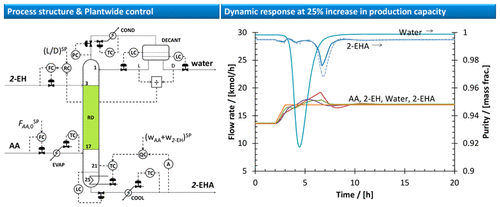What is 2-ethylhexyl acrylate used for? Is 2-ethylhexyl acrylate toxic?
Release time: May 2, 2025
Have you ever wondered what makes certain adhesives stick so well or why some paints remain flexible and durable? The answer might lie in a chemical called 2-ethylhexyl acrylate (2-EHA, CAS No. 103-11-7). This colorless, fruity-smelling liquid is a key ingredient in many everyday products, from adhesives and coatings to textiles and personal care items. But what exactly is it, and is it safe? Let’s break down the science behind this versatile compound.

What Is 2-Ethylhexyl Acrylate Used For?

2-EHA is primarily a monomer—a building block for creating polymers and copolymers. Its unique structure (featuring an acrylate ester group) gives it the ability to form flexible, durable, and water-resistant materials. Here’s where you’ll find it:
-
Adhesives & Sealants:
-
It’s a star player in pressure-sensitive adhesives (think sticky notes and tape) and construction adhesives, thanks to its ability to enhance tackiness and peel strength.
-
-
Coatings & Paints:
-
In water-based paints, 2-EHA helps create films that resist cracking and weathering. It’s also used in coatings for wood, paper, and textiles.
-
-
Textiles & Leather:
-
It adds durability and water repellency to fabrics and leather finishes.
-
-
Personal Care Products:
-
Found in hair gels and creams, 2-EHA helps formulations adhere smoothly to skin or hair.
-
-
Plastics & 3D Printing:
-
As a plasticizer, it softens materials, and it’s increasingly used in UV-curable resins for 3D printing.
-
Is 2-Ethylhexyl Acrylate Toxic?
It has been shown that less volatile lipophilic substances such as 2-EHA can stay on the skin longer than more volatile substances such as ethyl acrylate.
Table. Screening studies: C3H/HeJ mice dosed at 25 μl in acetone, 3 doses/week, lifetime exposure.
| Substance | Acrylic Acid | Ethyl Acrylate | n-Butyl Acrylate | 2-Ethylhexyl Acrylate | iso-Octyl Acrylate |
|---|---|---|---|---|---|
| CAS # | 79-10-7 | 140-88-5 | 141-32-2 | 103-11-7 | 29590-42-9 |
| Concentration | 1% | 100% | 1% | 75% | 5% |
| Carcinogenicity | – | – | – | + | – |
| Reported Irritation at Necropsy | NR | epidermal necrosis, dermatitis, dermal fibrosis, hyperkeratosis | NR | NR | crusting, dermatitis, hyperkeratosis, epidermal hyperplasia and melanosis |
| Vapor Pressure (hPa 25 °C) | 5.29 | 40 (21 °C) | 5 (22 °C) | 0.24 | 1 (20 °C) |
| Log Pow (25 °C) | 0.46 | 1.18 | 2.38 | 4.64 | 4.5-4.7 |
| Predicted skin absorption | 68.0% | 68.0% | 99.3% | 99.6% | 99.6% |
Like many chemicals, 2-EHA’s safety depends on exposure levels. Here’s what research says:
Potential Risks:
-
Irritation: It can irritate the skin, eyes, and respiratory tract upon contact or inhalation.
-
Sensitization: Repeated exposure may cause allergic skin reactions in some people.
-
Flammability: With a flashpoint of 85°C (185°F), it’s flammable and should be stored away from heat.
Reassuring Facts:
-
Low Acute Toxicity: If ingested accidentally, it’s unlikely to be lethal (rat studies show low oral toxicity).
-
Not Carcinogenic: No evidence links 2-EHA to cancer or DNA damage.
-
Environmental Impact: It breaks down relatively quickly in nature and isn’t considered highly persistent.
Safety Tip: Workers handling 2-EHA should wear gloves and goggles, but everyday consumers encounter it only in trace amounts within finished products—where risks are minimal.
The Bigger Picture: Balancing Use and Safety
While 2-EHA isn’t “highly toxic,” its industrial use is regulated (e.g., under REACH and OSHA) to limit exposure. Scientists are also exploring greener alternatives, such as bio-based acrylates, to reduce environmental concerns.
Bottom Line:
-
In products? Generally safe when properly formulated.
-
Handling it raw? Caution needed—follow safety guidelines.
Next time you peel off a sticker or admire a glossy coat of paint, remember the science behind it—and rest easy knowing that, like many additives, 2-EHA’s risks are well-managed in modern applications.
*References: GHS classification, REACH guidelines, and toxicology studies on 2-EHA.*
What is titanium dioxide used for? Should it be avoided?
Titanium dioxide (TiO₂, CAS No. 13463-67-7) is a white, powdery substance found everywhere—from your sunscreen to your toothpaste, and even in some foods. But is it safe? Let’s break down its uses and the controversies surrounding it.
Can I get tirzepatide for weight loss? What are the drawbacks of tirzepatide?
If you’ve been following the latest buzz in weight loss medications, you’ve probably heard of tirzepatide (brand names: Mounjaro for diabetes, Zepbound for weight loss). This once-weekly injection has been hailed as a game-changer for obesity treatment—but how does it work, who can use it, and what are the downsides? Let’s break it down.
Sulfuric Acid
CAS number:7664-93-9
Bpc 157
CAS number:137525-51-0
Potassium chloride
CAS number:7447-40-7
Isophorone
CAS number:78-59-1
Sodium Hyaluronate
CAS number:9067-32-7
Formaldehyde
CAS number:50-00-0
Contact Us
We supply all kinds of reagents and raw materials, focus on research and development, and integrate chemical synthesis, purification technology and small-scale, pilot and mass production supply chain construction.Email:net.fei@163.com
